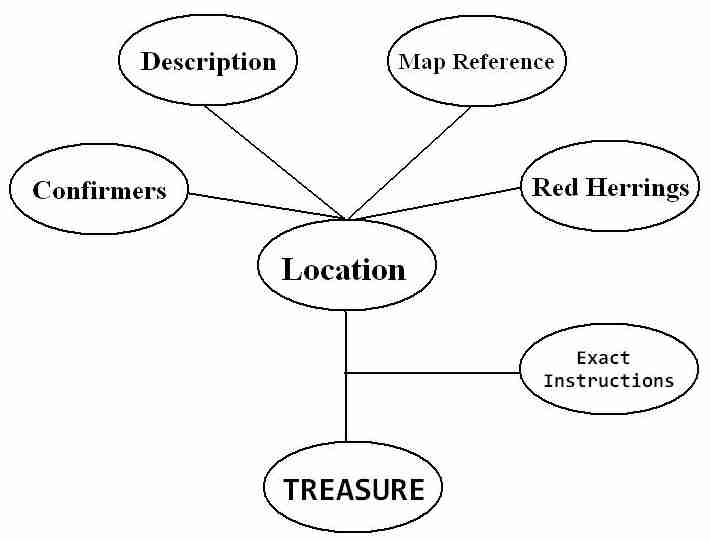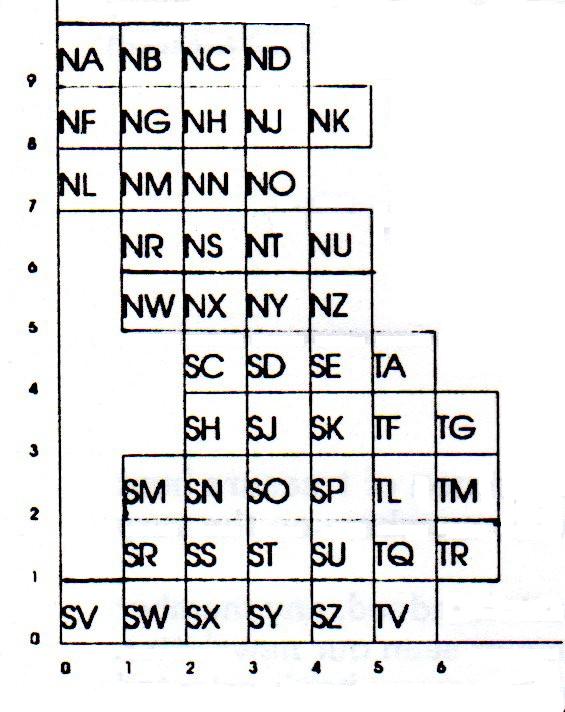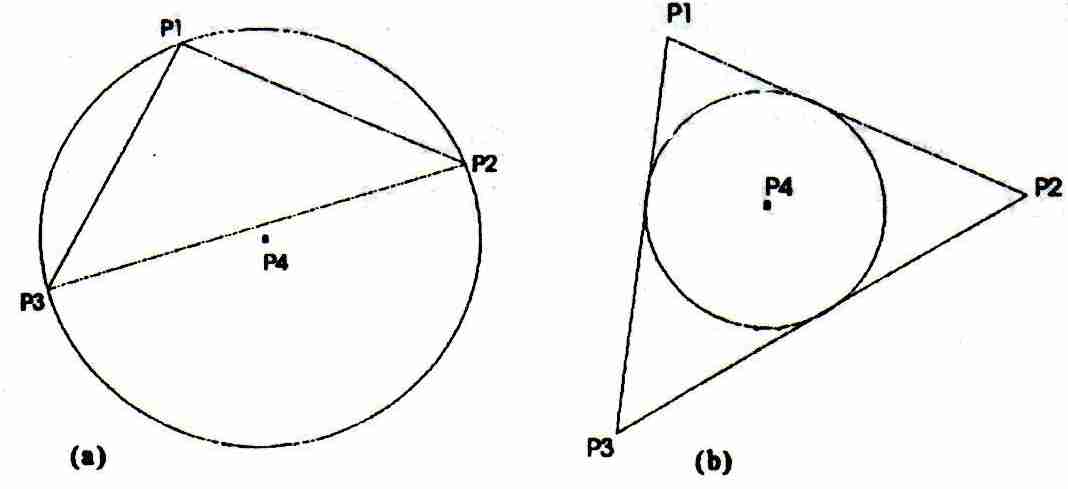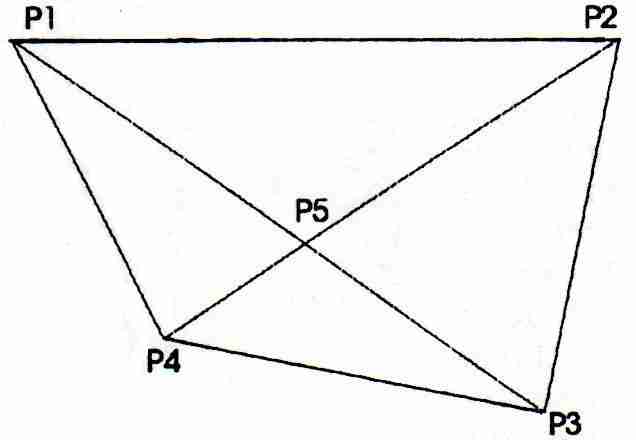The Armchair Treasure Hunt Club
|
| This article first appeared in the September 1992 (issue
4) newsletter. Newsletters are sent
quarterly to all current members.
© 2002 all rights reserved. Reproduction is prohibited. |
After much pondering chin stroking and head scratching, Mark Parry assembled the following article in an effort to focus on treasure hunting’s many unusual facets. Mind you, I get the distinct feeling there’s still a good bit of pondering to go...
How many of you on a clear moonlit night, having just ' parked the car or brought the washing in, find yourself looking up at the infinity we call ‘space’, then slowly down at silhouetted rolling distant hills that cover our tiny green England, on our blue- green world. I always feel a sudden rush of adrenaline that sends tingles down my spine. All I can think of is not the vastness of space, but that out there in our small land are so many buried treasures, and right here, right under my nose, are the instructions waiting to be read, waiting to direct me to the secret place of burial.... It’s as simple as that. Well... maybe not!
The thing that must be realized about Treasure Hunts is that once you know the solution, it’s obvious! At the first glimpse of the hard truth, we flap around in circles for ten minutes trying to kick ourselves at the sudden realisation of our own amazing ability to overlook ’the obvious’. This simple point is very important when considering comments made by puzzle designers; "... The treasure is as likely to be found by a bright child of ten…”. Or as Fred Hancock has said many times "It’s so easy, I don’t understand why it hasn’t been solved yet?". Yes Fred... you designed and buried it, of course it’s easy! But what of us, the poor lost souls with the Herculean task of unravelling a few obscurely scattered clues, amongst an overflowing mass of irrelevancies?
Let’s start with the treasure hunt book, which if it were to be read by any ’normal’ person would be perceived as a ’nice’ book with pretty, but slightly weird, pictures. They would certainly not be concerned with questions such as, what significance do the gemstones have'? And what design of pottery is that on the bookshelf? (I went a long way down the Helium Dream path with Carly, and what looked to be Majolica Ware). Whilst Joe Public puts the book down on the coffee table for bored visitors to read, or stand their coffee cups on, the ardent Treasure Hunter retreats into his room with a magnifying glass, a bookshelf full of reference books, graph paper and many other assorted implements of mental torture never to be seen again; Except that is to check the morning post to see if the latest edition of "The Armchair Treasure Hunt Club" newsletter has arrived! So the book itself is of course the main part, at least for the participant. A photo of the treasure being the closest that most will come to owning it. We totally immerse ourselves in the book, which quickly becomes the fictional battleground in our factual quest.
The second element to the hunt is the actual puzzle itself, which somehow leads to a place on our planet probably only a few square inches in size. There is only one sure fire way of being able to describe the location of an item of buried treasure accurately enough to make it practical for a third party to locate at some future time. That is by burying it relative to some fixed object that is unlikely to be moved or relocated. Examples of these are:
Masquerade - Catherine’s Cross, Ampthill
Piper of Dreams -The Cook Monument, Easby Moor
Helium Dream - The Twelve Apostles, Ilkley Moor
And to a lesser extent in Conundrum where there was an extra demand that the treasures be discovered relatively quickly due to publicity requirements.
Prof. Egghead - Tree - Cardington to Old Warden Rd
Conundrum - Road Sign - Farmyard Largo Law
A Giants Place - Dividing Cave Wall - A59
The Prize - The Rollright Stones - Long Compton
Easter Monday - Signpost - Ribchester footpath
"W" and "B" - Vertical Slits in Wall - Pickering Castle
The Refuge - Centre of Doorway - Methodist chapel A54
A Child‘s Dream - Road Sign - Alfold, lfold & Dunsfold
J Tregeagle - Tree - by gatepost Hth Cross/Itton Ham.
The Burning Hand - Doorway - Coach & Horses Cafe A66
Cuckoo Cuckoo - Road Sign - Near Misterton Station
Island Mystery - Grave - Maughald churchyard

We now have to decide how to convey the location of this larger more recognizable object, and secondly how to accurately pinpoint the burial position relative to this locator. At this point I would like to introduce a small diagram, mainly to introduce two further puzzle components, Confirmers and Red Herrings.
Confirming clues are usually designed such that as you are solving the master puzzle, which points to the locator, you will have helpful little hints to encourage you on your way. Unfortunately due to the very complexity or obscure nature of the master puzzle, most Treasure Hunters tend to get too involved in following vague confirming clues and getting totally on the wrong track (Remember the Majolica pottery on the bookshelf in HD!). The master puzzle should add up to a tidy, reasonably logical, and harmonious whole. Confirmers are just that, they confirm the solution, they don’t find it. Before my rather prophetic momentary state of mind passes, think hard on the following:
”One or more confirmers do not a solution make!"
Red herrings on the other hand should be an intellectual puzzle, which once solved will be seen to be truly Red. However they may be used purely to throw you off the scent.
So, how do we find our locator? There are normally two different methods that are used to describe the position of the locator. The first is the ’how to get to the place' description type puzzle. This is I believe hardest to solve and as such the most difficult to give any pointers to aid its location. If it is a specific method applied to each page of the book you will have a better chance than if it is just a random word selection, vaguely implied by a small portion of a picture or riddle. It may be a straightforward description, i.e., the name of an object, or a cryptic or both. Each I believe is as impossible to decipher as the other due to the enormous permutations.

The second method is the use of a map reference. With a map reference I believe we may have a slightly better chance. By virtue of the knowledge we have that the treasure is buried in mainland Britain we can assume that we are either looking for a two letter code and two, three digit numbers e.g. SE l23 456 (l:50,000 scale - Landranger), or two, four digit numbers e.g. 1234 5678 (1:25,000 scale - Pathfinder).
The map of Britain is divided into l00km2 squares numbered 0-6 West / East and 0-9 South / North. Each square is allocated a two-letter code thus allowing any 100m2 area of land to be represented by two letters and six digits or eight digits. Now that we have a rough idea what we are looking for we can start searching for patterns of numbers and letters that we can use as map references. The map references we find may not be directly related to the position of our locator, but may need to be combined with other information or map references to give an otherwise unrelated map reference.

If we have two points we could draw a line between the points and locate a third point at its centre.

If we have three points we could form a triangle and find the point, which is an equal distance from each point (a), or an equal distance from each edge and perpendicular to the edge (b).

If we have four points we could form a quadrilateral and locate the point on the intersection of the lines drawn between opposite corners.
Each of these points may be arrived at by either graphical or numerical methods. Having calculated a new map reference we can then start searching for our locator and any confirmers that may guide us on our way. Many treasure hunt book puzzles are based around one extremely difficult master riddle, with a few confirmers and red herrings thrown in. This can be very tedious, often leading to the book being quickly deposited on the shelf. The solutions however, usually turn out to be reasonably ingenious, again leaving one with the feeling it wasn’t that difficult after all.
There is one type of Treasure Hunt book however, that is typified by ’Spirit of the Stones’ and ’With Interest'. This is the multiple puzzle book. Each page poses several challenges, puzzles, codes etc., and allows the Treasure Hunter a gradual progression to the final solution. There will be some form of master riddle to solve but there is a very positive feeling of getting somewhere that tends to be absent from the more traditional Treasure Hunt book. Other examples of this type are S.Y.T.Y.K.A.A. Cheshire, The Mysterious Muddle and Chase 100.
The final major part of this dissection is the treasure itself - the very nucleus of this strange hobby of ours. For most of us, it’s the idea of ultimate discovery that carries us forward in our sometimes seemingly endless search for the answer. The treasure usually relates in some way to the story, and is often something ’lost’ by a character within the story. It is usually made from precious stones and metals, gold being the most favoured by treasure hunt designers. One thing to bear in mind on this aspect is: What do you do with the treasure when you’ve found it? Most treasures cannot be worn or used as a jewellery item, and I’m sure I wouldn’t leave a úl2,500 wand sitting on my mantelpiece! If ever you do discover a treasure, remember that for possibly years of striving and searching, you may have one brief moment of ecstatic triumph which I strongly suspect will be followed by an awful emptiness.... that is until you begin another.
In conclusion there simply are no hard and fast rules for solving Treasure Hunt book puzzles. If there were I would have solved one by now! All I can say is that the successful Treasure Hunter should be a lover of books, have access to a wide range of knowledge and most of all, be tirelessly persistent. Good luck in your future ad- ventures, and don’t ever give up on your treasured dreams....